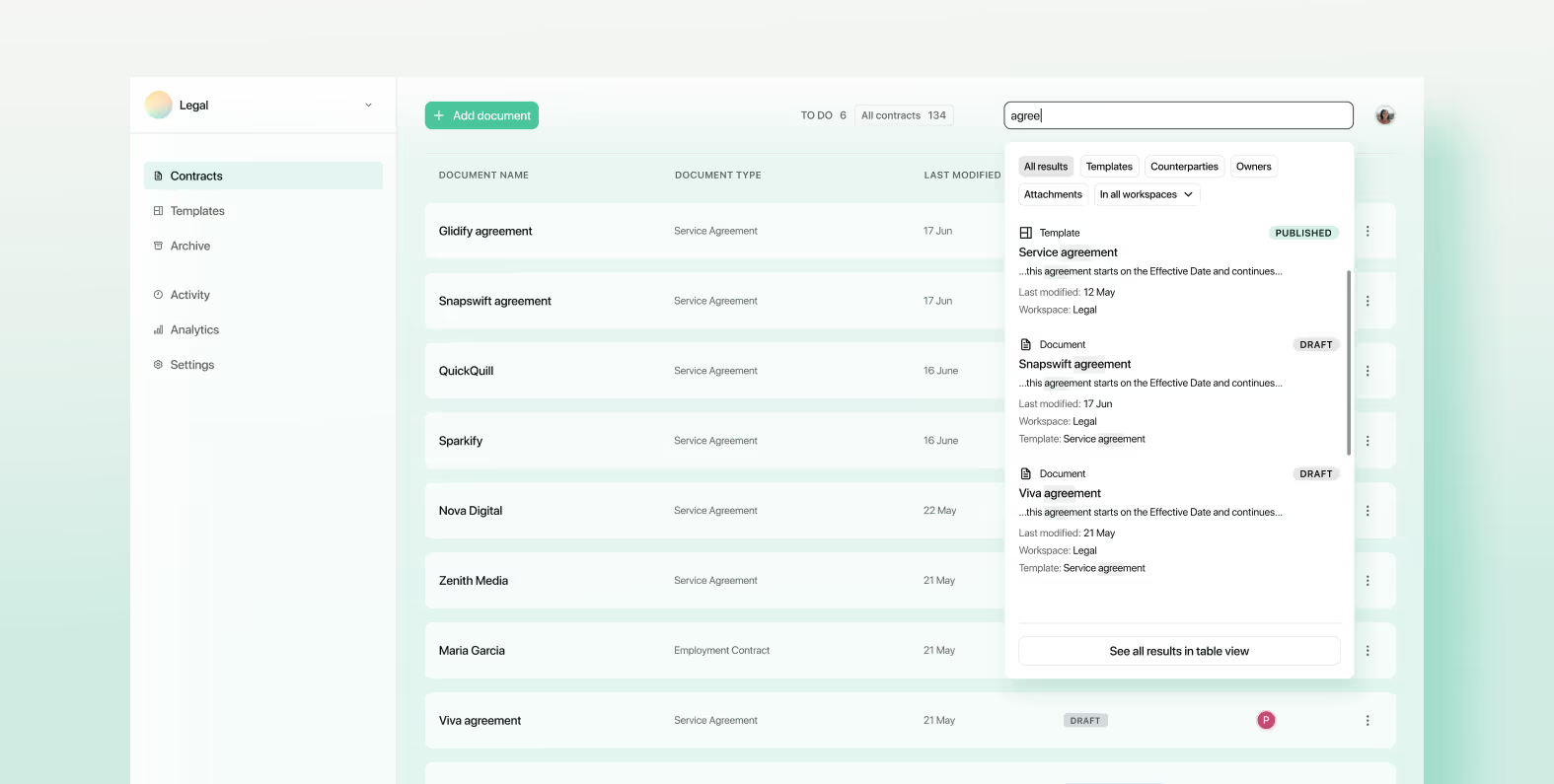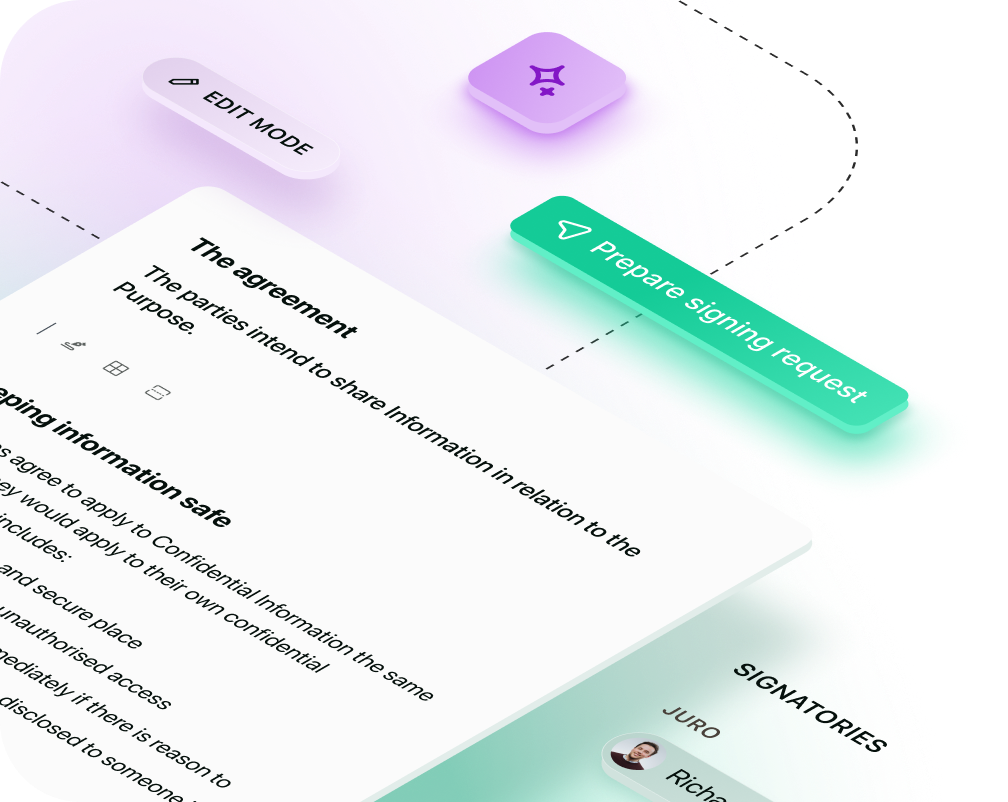Solutions
Customer Support
Resources
Clarify expectations with this free virtual assistant agreement template, detailing services, hours, and payment terms.




This guide will walk you through the essentials of virtual assistant agreements, what they should include and how Juro can simplify the management of these contracts.
A virtual assistant agreement is a formal contract between a client and a service provider who performs various administrative, creative or technical services remotely.
This legal document outlines the terms and conditions of the employment relationship, including duties, duration, payment details, confidentiality agreements and grounds for termination. It ensures clear communication and mutual understanding, safeguarding the interests of both parties and facilitating a smooth working relationship.
A virtual assistant agreement serves to:
Management of virtual assistant agreements typically falls under various roles within an organization. Legal teams ensure the contract complies with relevant laws and regulations. HR departments oversee the agreement process to align it with company policies. And direct supervisors or project managers handle day-to-day management and make sure that the contract terms are adhered to.

Virtual assistant agreements are used in several scenarios. For example, when businesses or entrepreneurs need ongoing administrative support without a full-time hire, or when specialized skills are needed for specific projects or tasks but are not available in-house. These agreements are also used to increase capacity during peak periods or when scaling up operations.
A robust virtual assistant agreement template should cover the following key elements in detail:
Services provided. Clearly define the scope of work, tasks, and responsibilities. Specify the types of services the virtual assistant will perform, such as administrative support, social media management, customer service or technical support. Include any specific tools or software the virtual assistant will use and any expected deliverables or milestones.
Duration of contract. Specify whether the engagement is ongoing or for a specific term. Include start and end dates if applicable, and outline the process for contract renewal or extension. Clarify whether the agreement is for a fixed-term project, a rolling month-to-month arrangement, or an indefinite period subject to periodic review.
Payment terms. Include detailed information on rates, billing cycle and payment methods. Specify the hourly rate, flat fee or project-based pricing. Outline the invoicing schedule (e.g., weekly, bi-weekly, monthly), acceptable payment methods (e.g., bank transfer, PayPal), and any late payment penalties or incentives for early payment.
Confidentiality. Address the handling of confidential information. Include a non-disclosure agreement (NDA) to protect proprietary information and trade secrets. Specify the types of information considered confidential, the duration of confidentiality obligations and any exceptions to these obligations. Detail the consequences of a breach of confidentiality.
Termination conditions. Outline how either party can terminate the contract. Include conditions for termination with cause (e.g., breach of contract, failure to meet performance standards) and without cause (e.g., either party decides to end the agreement). Specify notice periods for termination, any severance or final payment arrangements, and the return or destruction of confidential information upon termination.
Legal jurisdiction. State the governing law for the contract. Specify the jurisdiction whose laws will govern the agreement and any disputes that may arise. Include a clause on dispute resolution mechanisms – such as mediation or arbitration – before resorting to litigation.
Intellectual property rights. Clarify the ownership of any work product created by the virtual assistant. Specify whether the client retains full ownership of all deliverables and intellectual property created during the engagement or if any rights are shared or retained by the virtual assistant.
Performance standards. Outline the expected performance standards and quality of work, including metrics or KPIs. Specify any required training, certifications or ongoing professional development.
Communication protocols. Define the communication methods and frequency. Specify preferred communication channels (e.g., email, phone, video calls), response times and regular check-in meetings or status reports. Include expectations for availability and time zone considerations.
Expenses and reimbursements. Detail any expenses that the virtual assistant is authorized to incur on behalf of the client and the process for reimbursement. Specify what expenses are covered, documentation required for reimbursement and the timeline for processing expense claims.
Equipment and tools. Outline any equipment or tools that the client will provide to the virtual assistant. Specify the virtual assistant's responsibility for maintaining and returning any client-owned equipment. Include provisions for using personal equipment and ensuring data security.
.avif)
Managing virtual assistant agreements manually can be cumbersome and inefficient, often involving several detailed steps:
Adjusting templates for different roles or tasks can be a time-consuming process. Each new virtual assistant or project may require specific modifications to the agreement template to accurately reflect the unique responsibilities, expectations and terms of the engagement. This customization process often involves manually editing documents, which increases the risk of inconsistencies and errors.
Keeping track of physical or digital copies of agreements poses significant challenges. Physical contract storage requires maintaining organized filing systems, which can quickly become cluttered and difficult to manage as the number of agreements grows.
Digital storage, while more convenient, can also become problematic if agreements are scattered across various devices, email attachments and cloud storage services. This disorganization can make it difficult to quickly retrieve and reference specific agreements when needed.
Handling approvals through emails or in-person meetings can lead to significant delays and inefficiencies. The traditional approval process often involves sending documents back and forth via email, collecting feedback, making revisions, and waiting for stakeholders to review and sign off.
Coordinating in-person meetings for approvals can further slow down the process, especially when dealing with busy schedules and multiple stakeholders. This manual approach not only consumes valuable time but also increases the likelihood of miscommunication and missed details.
While functional, this manual process can be incredibly time-consuming and prone to errors, which is inefficient for growing businesses. The administrative burden of managing agreements manually can divert resources from more strategic activities, hinder productivity and introduce potential risks related to contract compliance and management.
Automating virtual assistant agreements in Juro can significantly streamline the contract management process, reducing errors and saving time. Here’s how you can leverage Juro’s features to automate your virtual assistant agreements:


By leveraging these features, Juro helps businesses automate the entire lifecycle of virtual assistant agreements, from creation to execution to storage. This not only improves operational efficiency but also ensures that contracts are managed in a secure, compliant and consistent manner.
Juro's AI-native contract automation platform empowers all teams to create, agree, execute and manage contracts up to 10x faster than traditional tools. To find out more, hit the button below to book your personalized demo.
Juro is the #1-rated contract platform globally for speed of implementation.


Juro embeds contracting in the tools business teams use every day, so they can agree and manage contracts end-to-end - while legal stays in control.
Book your demo